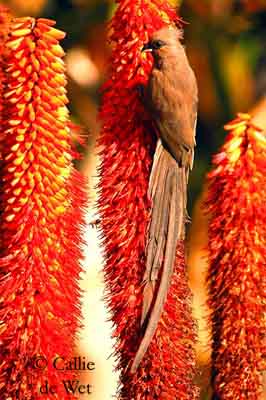
Speckled Mousebird
Colius striata
Coliiforme Order - Coliidae family
BIOMETRICS:
Length: 30-36 cm; Weight: 50-57 g
DESCRIPTION:
Speckled Mousebird’s name comes from the similar appearance of this bird with a mouse, when it moves through vegetation.
Adult male has brownish to ashy brown plumage.
On the upperparts, mantle and rump show indistinct fine dark bars, visible at close range. Wings and tail are brownish. Tail is very long, about 18 to 24 cm.
On the underparts, plumage is buffier than above. Throat is dark grey. Neck and breast show the same fine barring as in mantle. Belly is buff. Underwing is brownish, with greyish tips in flight feathers.

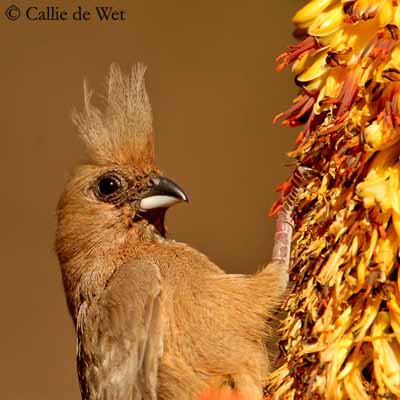
On the head, forehead is dark brown to blackish, as lores and throat. Ear-coverts and crest are pale brownish.
Strong, decurved bill is two tones. Upper mandible is black and lower mandible is whitish. Eyes are dark brown, with blackish eye-ring of bare skin. Legs and feet are dark pinkish-red.
Both sexes are similar.
Juvenile has shorter crest and lower mandible darker than in adults. It has a whitish stripe in centre of lower back, and wing coverts are edged buff. It reaches its sexual maturity at one year.
We can find 17 subspecies which differ in tones of plumage and contrasts of colours. Colour of the eyes can be from dark brown to whitish, through pale blue.
VOICE: SOUNDS BY XENO-CANTO
Speckled Mousebird is a noisy species. It utters distinct alarm calls, according to the kind of danger. It gives a loud “shriek” for terrestrial predators, and mostly an explosive “pit” for aerial predators. These calls are uttered in rapid series, with crest alternately raised or flattened.
Contact calls “chew-chew” are uttered when the birds form a group, perched in treetops or flying together from tree to tree. We can also hear some warbling and other alarm calls “tisk-tisk” uttered in flight.
HABITAT:
Speckled Mousebird frequents open habitats, forest edges and clearings, savannahs, abandoned cultivated areas, open bushveld, hedges, parks and gardens in suburban areas.
This species avoids arid regions and dense woodlands. It can be seen from sea-level up to 2100 to 2800 metres of elevation.
RANGE:
Speckled Mousebird lives in Centre and East of Africa, and in southern South Africa.
It is highly sedentary in its range, and only performs some altitudinal movements according to food resources.
BEHAVIOUR:
Speckled Mousebird is often seen in groups of up to 20 birds at roosts. This species lives in flocks all year round, including breeding season. These groups of 7-8 birds are probably family groups. They perform their daily activities communally, with constant contact calls. They often have physical contacts when perched very close to each other in trees.
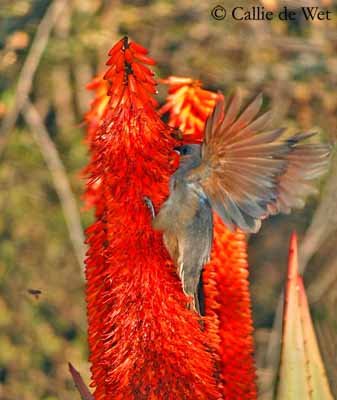
Speckled Mousebird feeds mainly on plant matter such as fruits, buds, flowers and leaves. It also consumes nectar. This bird damages orchards and plantations, eating cultivated fruits and flowers of ornamental vegetation. This species can be seen taking clay-earth, and it sometimes eats ants and termites. When drinking, the Speckled Mousebird sucks up the water, as Columbidae.
Speckled Mousebird performs sun-bathing, in order to maintain normal body temperature. These birds often feed on fruits low in calories, and Speckled Mousebirds are able to go into torpor during these periods for saving energy. They can reduce their body temperature of up to 20°C, and that explains why solar radiations are necessary. For that, the bird perches on exposed branch with ruffled feathers and wings opened in arc on body sides. Dusk-bathes are also frequently used to decrease parasite loads.
Speckled Mousebird performs limited daily movements, resting together instead moving. They roost in trees and shrubs in groups, and sleep more than other birds’ species.
During breeding season, Speckled Mousebird utters various courtship calls, associated to mutual preening and courtship feeding. Some displays show the birds perched in erect posture on a branch or on the ground, and moving up and down during several minutes, and even performing some hopping of some centimetres in the air. Male and female perform these displays before copulation.
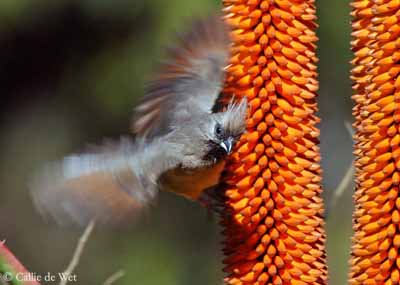
FLIGHT:
Speckled Mousebird fly in family groups. The birds fly in single file with alternated humming wing-beats and glides with stiff long tail feathers.
REPRODUCTION:
Speckled Mousebird can breed all year round, with a peak in September-January in South Africa. This species is monogamous, and may have helpers.
The nest is situated in tree or bush, at 2 to 3 metres above the ground. Nest is a loose, fairly large open bowl, made with several materials such as twigs, stems, leaves, plant down, lichens, spider webs and other matters like wool, cloth, paper and string. Interior is lined with softer materials, and exterior is often decorated with green plants and flowers.
Female lays 2 to 3 eggs. Sometimes, several females can lay in the same nest. Incubation lasts about 10 to 11 days, shared by both parents.
Chicks leave the nest about ten days after hatching, and they are able to fly at 17 to 18 days of age. Young are fed by both parents and helpers for one month after fledging.
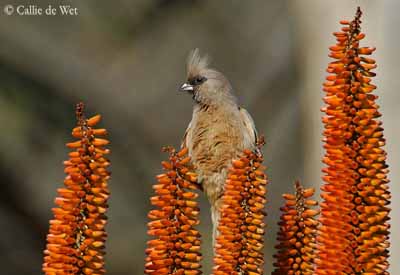
DIET:
Speckled Mousebird feeds mainly on ripe and unripe fruits, plant matters such as leaves, buds, blossoms, flowers and nectar, and some insects like ants and termites. They also consume clay-earth.
PROTECTION / THREATS / STATUS:
Speckled Mousebird is widespread and common in most parts of its range. This species is not globally threatened at this moment.
Fr: Coliou rayé
All : Braunflügel-Mausvogel
Esp : Pájaro-ratón Común
Ital : Uccello topo macchiettato
Nd : Bruine Muisvogel
Russe : Полосатая птица-мышь
Photographs by Callie de Wet
GALLERY
Text by Nicole Bouglouan
Sources:
HANDBOOK OF THE BIRDS OF THE WORLD Vol 6 by Josep del Hoyo-Andrew Elliott-Jordi Sargatal - Lynx Edicions, 2001 - ISBN: 848733430X
BIRDS OF AFRICA SOUTH OF THE SAHARA by Ian Sinclair and Peter Ryan - Princeton University Press Princeton and Oxford - ISBN: 0691118159
L’ENCYCLOPEDIE MONDIALE DES OISEAUX - Dr Christopher M. Perrins - BORDAS - ISBN: 2040185607
Wikipedia (Wikipedia, The Free Encyclopedia)